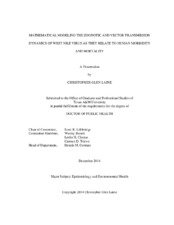| dc.description.abstract | West Nile virus (WNV), an arthropod-borne flavivirus, naturally circulates between passeriform birds and mosquitoes. Other vertebrates, such as humans, may become infected during the bloodmeal of infectious mosquitoes. WNV initially invaded New York in 1999, rapidly swept west across the North American continent, and is now endemic across the continental United States. The focus of this study was to use mathematical modeling, for improving current public health understanding on how infectious cycles of birds and mosquitoes, infection and cross-infection, and environmental dynamics of WNV, along with human pathology, influences human morbidity and mortality in the Dallas, Tarrant, and Denton counties of Texas.
During a comprehensive literature review of WNV, avian pathophysiology, public health entomology, human pathophysiology, and epidemiology, we proposed a novel mathematical model. Subsequently, we developed an epidemic model of the WNV dynamics, in the avian host (American crow), mosquito vector (Culex), and two age classifications of humans (≤39 & ≥40). The bifurcation of human age was conducted due to the risk of humans developing neuroinvasive disease increases 1.5X for every decade of life. We also divided human infected classes into asymptomatic, West Nile Fever (WNF), and West Nile neuroinvasive disease (WNND), as WNND is the only fatal form. The model was then calibrated to observed data, from the endemic years between 2003-1012. A sensitivity analysis of each individual variable and parameter was conducted to test influence on human morbidity and mortality. Focusing on the most sensitive variables, we conducted a multivariate analysis, in which we formulated situations such as drought, avian concentration and population fragmentation, insecticide usage, larvae side usage, and habitat modification through the reduction of standing water.
We were able to successfully simulate the endemic years, and outbreaks, between 2003 and 2012, but underestimated the outbreak year of 2012. This model illustrates the observed link between infected mosquito densities to human health outcomes. Climate changes that effect the mosquito population and their interaction with humans have been shown to be important factors influencing human morbidity and mortality. In the future this model may also be useful in predicting the effect of various disease control strategies. | en |


